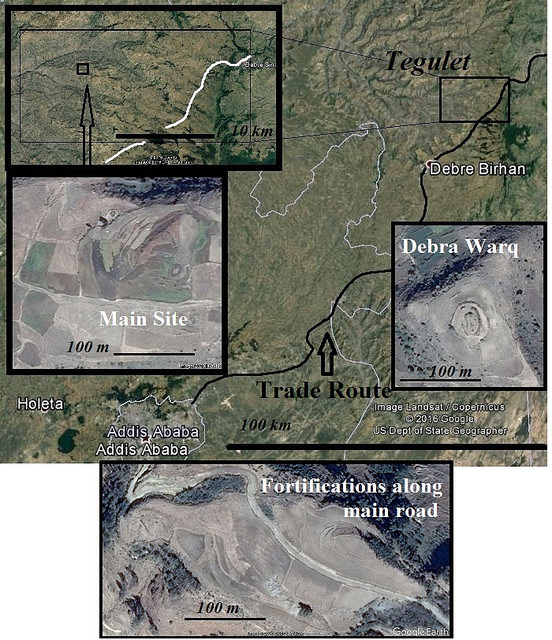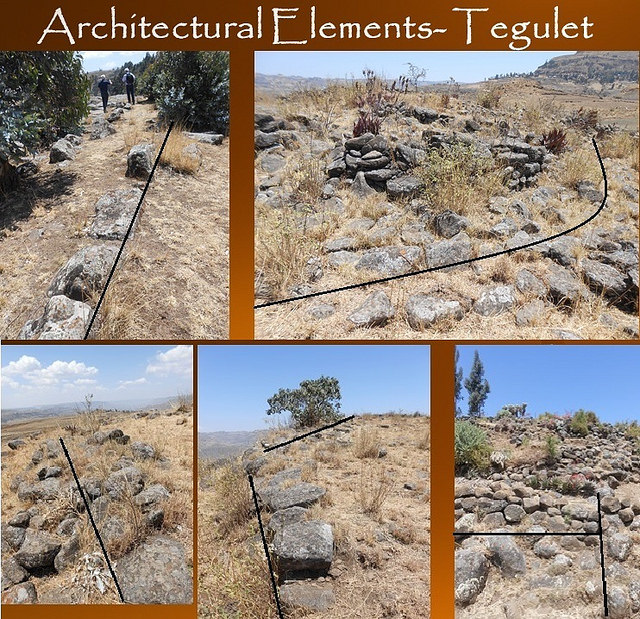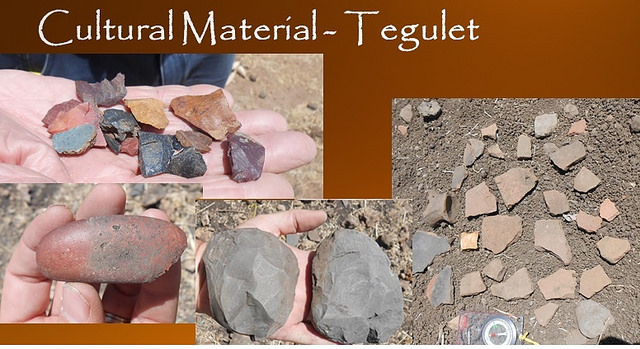
-
Revelations
- Senior Member+
- Posts: 33713
- Joined: 06 Jan 2007, 15:44
Long-Lost cities of Ethiopia: Tegulet
As if on cue, another long-lost city, Tegulet, asserted its presence. All place-memory of this medieval capital had vanished. Though it is mentioned throughout the medieval period as the capital of Abyssinia, its location remained a mystery. Utilizing the remote sensing methodology we had devised, and adding our new variable, we narrowed our search to a series of ridges along the Jemma River drainage basin, west of the ancient trade routes and north of Debra Berhan, the new city established by Emperor Zara Yaqob in 1456.


-
Revelations
- Senior Member+
- Posts: 33713
- Joined: 06 Jan 2007, 15:44
Re: Long-Lost cities of Ethiopia: Tegulet
Within less than twenty minutes of scanning images on Google Earth, given our set parameters, we had identified three possible candidates for occupational-sites with probable architectural features. Hopeful, we again ventured forth for a two-day excursion with a team from Addis Ababa University. Driving along the main ridge we had identified, we inquired of locals and were told the place was called Addis Ga, “the New Place.” (አድስጌ) So, there had been an “old place” somewhere nearby. Another name repeatedly given was Debra Warq, “the Hill of Gold.” A designation of Tegulet was never volunteered. Eventually we inquired, “Have you heard of Tegulet?” Most gave a shrug or mentioned a region at the end of the valley by that name, yet no one knew for sure. A bit disappointed, we continued walking west, descending the narrow ridge toward our main sites, ten and twelve kilometers further west.
Less than a kilometer in, atop a flat plateau to the north, we discovered our first evidence of architecture comprised of a double coursing of monumental stones. Just beyond, the track dropped along a narrow escarpment, where oddly, a road had been carved into the hillside. At the base of the cliff, the road continued with pavers imbedded in the earth. Three hundred meters further, where the road ascended a slight slope, the bedrock showed evidence of ruts cut by wheeled vehicles over a period of perhaps several centuries.

Fig. 16 – The “Royal Road”: left- ruts; center- the pavers; right- terraced road. Note, the left terrace is modern. (Photo credit – SCW)
Less than a kilometer in, atop a flat plateau to the north, we discovered our first evidence of architecture comprised of a double coursing of monumental stones. Just beyond, the track dropped along a narrow escarpment, where oddly, a road had been carved into the hillside. At the base of the cliff, the road continued with pavers imbedded in the earth. Three hundred meters further, where the road ascended a slight slope, the bedrock showed evidence of ruts cut by wheeled vehicles over a period of perhaps several centuries.

Fig. 16 – The “Royal Road”: left- ruts; center- the pavers; right- terraced road. Note, the left terrace is modern. (Photo credit – SCW)
-
Noble Amhara
- Senior Member
- Posts: 11702
- Joined: 02 Feb 2020, 13:00
- Location: Abysinnia Highlands
Re: Long-Lost cities of Ethiopia: Tegulet
You mean Long Lost City of Abysinnia : Tegelut!
We don’t want no outsiders. This is our history. Only for us highlanders of Abysinnia. You using the name “Ethiopia” attracts unwanted yelayla kilil ebaboch
We don’t want no outsiders. This is our history. Only for us highlanders of Abysinnia. You using the name “Ethiopia” attracts unwanted yelayla kilil ebaboch
-
Revelations
- Senior Member+
- Posts: 33713
- Joined: 06 Jan 2007, 15:44
Re: Long-Lost cities of Ethiopia: Tegulet
In medieval Ethiopia, there is no record of wheeled vehicles, carts, chariots, or the like. Yet, we followed an obvious, built-road, wide enough for two vehicles with axels 185 cm, to the main site, a full ten kilometers along the ridge. In the fields all along the route, medieval cultural material abounded. When asked, our informants replied that similar things could be found in heavy concentrations further down the ridge.

Fig. 17 – Linear and circular architectural elements at Tegulet – (Photo credit – SCW)

Fig. 17 – Linear and circular architectural elements at Tegulet – (Photo credit – SCW)
-
Revelations
- Senior Member+
- Posts: 33713
- Joined: 06 Jan 2007, 15:44
Re: Long-Lost cities of Ethiopia: Tegulet
Two hard days of trekking produced ample proof this was indeed an area containing all the hallmarks of a substantial, if not royal medieval site. We documented five main areas containing dense concentrations of cultural material including pottery fragments, stone tools, cores, flakes, and iron slag. Architectural features including walls, towers, enclosures, and stone alignments, and stone abrading tools used for preparing manuscripts, along with debitage from semi-precious stones such as carnelian, jasper, agate, chalcedony, and corundum – used in jewelry, book covers, and vestments – were also discovered. Many seeps or small springs percolated sufficient water for year-long irrigation and for livestock. Locals retained no place memory of these sites; to them, these old places had simply always existed.
In reading Burton’s First Footsteps in East Africa for our desk-based analysis, I came across various accounts of Tegulet and the conflicts during the Imam Ahmad Gran wars of the late 1520’s through 40’s. Burton claims that much of the kingdom of Shoa was conquered by Islamic forces in 1528 accompanied by much destruction by fire (Burton, vol. II, pp.5). A century earlier, in 1456, Emperor Zara Yaqob established the new city of Debre Berhan, a mere 23 kilometers south of our proposed research area—this town of course appearing too late for the Fra Mauro map. Additionally, Tegulet is mentioned as the launching point of Emperor Amda Sion (1312-1342) against the lowlands of Adel and Ifat (Burton, vol. II pp.3-4). Emperor Alexander (reigned 1478-1495) was assassinated in Tegulet by his complicit bodyguard, forcing his successors, Naud and Dawit or David III, (died 1540) to live encamped in transient sites supported by the newly arrived Portuguese, engaging in conflicts with Imam Ahmad Gran, (ibid, pp. 6).
Burton relates one final intriguing episode. After the death of Imam Ahmad at the hands of the Portuguese (1543), Emperor Claudius began rebuilding a site known as Debra Warq, “a celebrated (Christian) shrine” destroyed by invading Islamic forces (ibid, pp11). He was killed in battle (1559) before completing the goal. While there are many sites with this name, at the furthest point upon our research ridge sits a ruin called Debra Warq with evidence of an extremely intense fire. The very soil itself still retains a burnt aspect a full five centuries on. Fire-cracked rock and elements of vitrification strew the landscape.

Fig. 18 – Tegulet cultural materials collection: top- flakes and debitage; lower left- abrasion stone for vellum preparation; center- early choppers; right- pottery shards from the main occupation site gathered in an area covering 25 meters. Photo credit – SCW
In reading Burton’s First Footsteps in East Africa for our desk-based analysis, I came across various accounts of Tegulet and the conflicts during the Imam Ahmad Gran wars of the late 1520’s through 40’s. Burton claims that much of the kingdom of Shoa was conquered by Islamic forces in 1528 accompanied by much destruction by fire (Burton, vol. II, pp.5). A century earlier, in 1456, Emperor Zara Yaqob established the new city of Debre Berhan, a mere 23 kilometers south of our proposed research area—this town of course appearing too late for the Fra Mauro map. Additionally, Tegulet is mentioned as the launching point of Emperor Amda Sion (1312-1342) against the lowlands of Adel and Ifat (Burton, vol. II pp.3-4). Emperor Alexander (reigned 1478-1495) was assassinated in Tegulet by his complicit bodyguard, forcing his successors, Naud and Dawit or David III, (died 1540) to live encamped in transient sites supported by the newly arrived Portuguese, engaging in conflicts with Imam Ahmad Gran, (ibid, pp. 6).
Burton relates one final intriguing episode. After the death of Imam Ahmad at the hands of the Portuguese (1543), Emperor Claudius began rebuilding a site known as Debra Warq, “a celebrated (Christian) shrine” destroyed by invading Islamic forces (ibid, pp11). He was killed in battle (1559) before completing the goal. While there are many sites with this name, at the furthest point upon our research ridge sits a ruin called Debra Warq with evidence of an extremely intense fire. The very soil itself still retains a burnt aspect a full five centuries on. Fire-cracked rock and elements of vitrification strew the landscape.

Fig. 18 – Tegulet cultural materials collection: top- flakes and debitage; lower left- abrasion stone for vellum preparation; center- early choppers; right- pottery shards from the main occupation site gathered in an area covering 25 meters. Photo credit – SCW